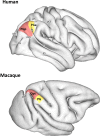Architecture and connectivity of the human angular gyrus and of its homolog region in the macaque brain
- PMID: 35695934
- PMCID: PMC9813232
- DOI: 10.1007/s00429-022-02509-7
Architecture and connectivity of the human angular gyrus and of its homolog region in the macaque brain
Abstract
The angular gyrus roughly corresponds to Brodmann's area 39, which is a multimodal association brain region located in the posterior apex of the human inferior parietal lobe, at its interface with the temporal and occipital lobes. It encompasses two cyto- and receptor architectonically distinct areas: caudal PGp and rostral PGa. The macaque brain does not present an angular gyrus in the strict sense, and the establishment of homologies was further hindered by the fact that Brodmann defined a single cytoarchitectonic area covering the entire guenon inferior parietal lobule in the monkey brain, i.e. area 7. Latter architectonic studies revealed the existence of 6 architectonically distinct areas within macaque area 7, further connectivity and functional imaging studies supported the hypothesis that the most posterior of these macaque areas, namely Opt and PG, may constitute the homologs of human areas PGp and PGa, respectively. The present review provides an overview of the cyto-, myelo and receptor architecture of human areas PGp and PGa, as well as of their counterparts in the macaque brain, and summarizes current knowledge on the connectivity of these brain areas. Finally, the present study elaborates on the rationale behind the definition of these homologies and their importance in translational studies.
Keywords: Angular gyrus; Connectivity; Cytoarchitecture; Homologies; Myeloarchitecture; Parcellation; Posterior inferior parietal lobe; Receptorarchitecture.
© 2022. The Author(s).
Conflict of interest statement
The authors have no conflicts to declare.
Figures




Similar articles
-
Microarchitecture and connectivity of the parietal lobe.Handb Clin Neurol. 2018;151:53-72. doi: 10.1016/B978-0-444-63622-5.00003-6. Handb Clin Neurol. 2018. PMID: 29519479 Review.
-
Occipital (V6) and parietal (V6A) areas in the anterior wall of the parieto-occipital sulcus of the macaque: a cytoarchitectonic study.Eur J Neurosci. 2005 Jun;21(11):3056-76. doi: 10.1111/j.1460-9568.2005.04149.x. Eur J Neurosci. 2005. PMID: 15978016
-
Organization of the macaque monkey inferior parietal lobule based on multimodal receptor architectonics.Neuroimage. 2021 May 1;231:117843. doi: 10.1016/j.neuroimage.2021.117843. Epub 2021 Feb 10. Neuroimage. 2021. PMID: 33577936 Free PMC article.
-
Architectonic organization of the inferior parietal convexity of the macaque monkey.J Comp Neurol. 2006 May 20;496(3):422-51. doi: 10.1002/cne.20933. J Comp Neurol. 2006. PMID: 16566007
-
Structural connectivity and functional properties of the macaque superior parietal lobule.Brain Struct Funct. 2020 May;225(4):1349-1367. doi: 10.1007/s00429-019-01976-9. Epub 2019 Nov 11. Brain Struct Funct. 2020. PMID: 31712901 Review.
Cited by
-
Specialized Networks for Social Cognition in the Primate Brain.Annu Rev Neurosci. 2023 Jul 10;46:381-401. doi: 10.1146/annurev-neuro-102522-121410. Annu Rev Neurosci. 2023. PMID: 37428602 Free PMC article. Review.
-
Developmental perspectives on the origins of psychotic disorders: The need for a transdiagnostic approach.Dev Psychopathol. 2024 Dec;36(5):2559-2569. doi: 10.1017/S0954579424000397. Epub 2024 Feb 26. Dev Psychopathol. 2024. PMID: 38406831 Free PMC article. Review.
-
Connectivity Reveals the Relationships between Human Brain Areas Associated with High-Level Linguistic Processing and Macaque Brain Areas.Tomography. 2024 Jul 12;10(7):1089-1098. doi: 10.3390/tomography10070082. Tomography. 2024. PMID: 39058054 Free PMC article.
-
Simultaneous tACS-fMRI reveals state- and frequency-specific modulation of hippocampal-cortical functional connectivity.Commun Psychol. 2025 Feb 3;3(1):19. doi: 10.1038/s44271-025-00202-z. Commun Psychol. 2025. PMID: 39900978 Free PMC article.
-
Relations of temporoparietal connectivity with neighborhood social fragmentation in youth at clinical high-risk for psychosis.Schizophr Res. 2025 Mar;277:151-158. doi: 10.1016/j.schres.2025.02.012. Epub 2025 Mar 10. Schizophr Res. 2025. PMID: 40068446
References
-
- Batsch E-G. Die myeloarchitektonische Untergliederung des Isocortex parietalis beim Menschen. J Hirnforsch. 1956;2:225–258. - PubMed
References in present special issue
-
- Bellana B, Mansour R, Ladyka-Wojcik N, Grady CL, Moscovitch M (2022) Recollection and prior knowledge recruit the left angular gyrus during recognition - PubMed
-
- Bush A, Bonnici HM (2022) The integrative nature of angular gyrus function in episodic memory recollection; merging theories into an integrative account
-
- Desai RH, Tadimeti U, Riccardi N (2022) People, places, and words in the semantic system - PubMed
-
- Graves W, Purcell J, Rothlein D, Staples R, Bolger D, Rosenberg-Lee M (2022) Correspondence between cognitive and neural representations for phonology, orthography, and semantics in supramarginal compared to angular gyrus - PubMed
Publication types
MeSH terms
Grants and funding
LinkOut - more resources
Full Text Sources
Miscellaneous

